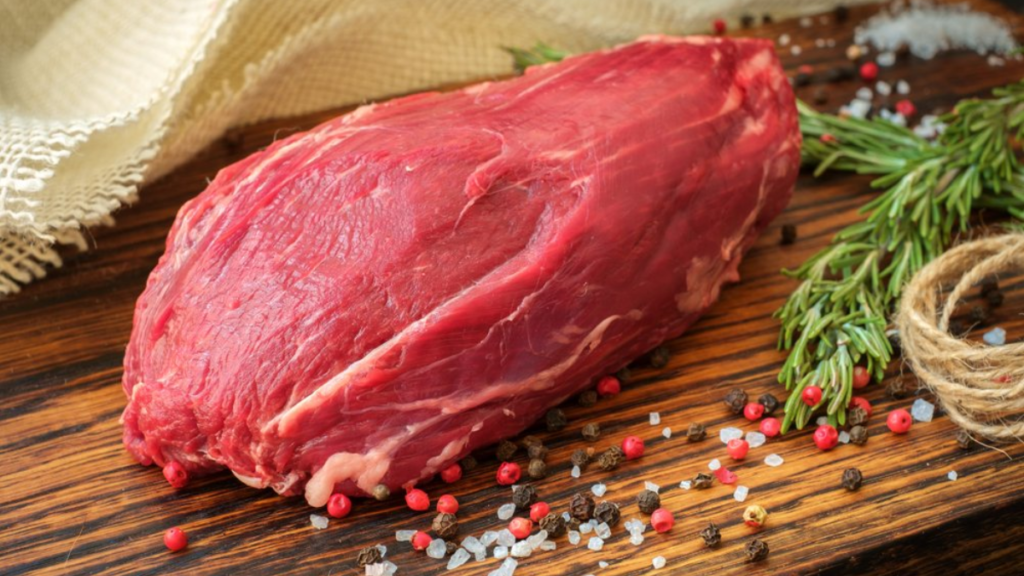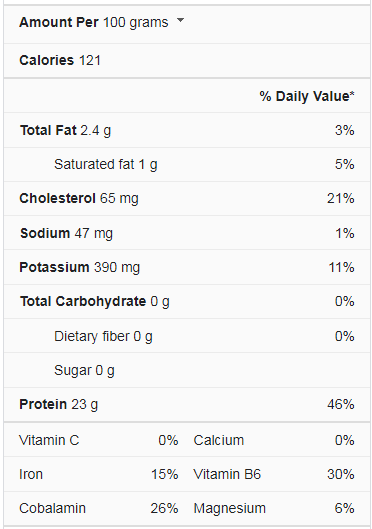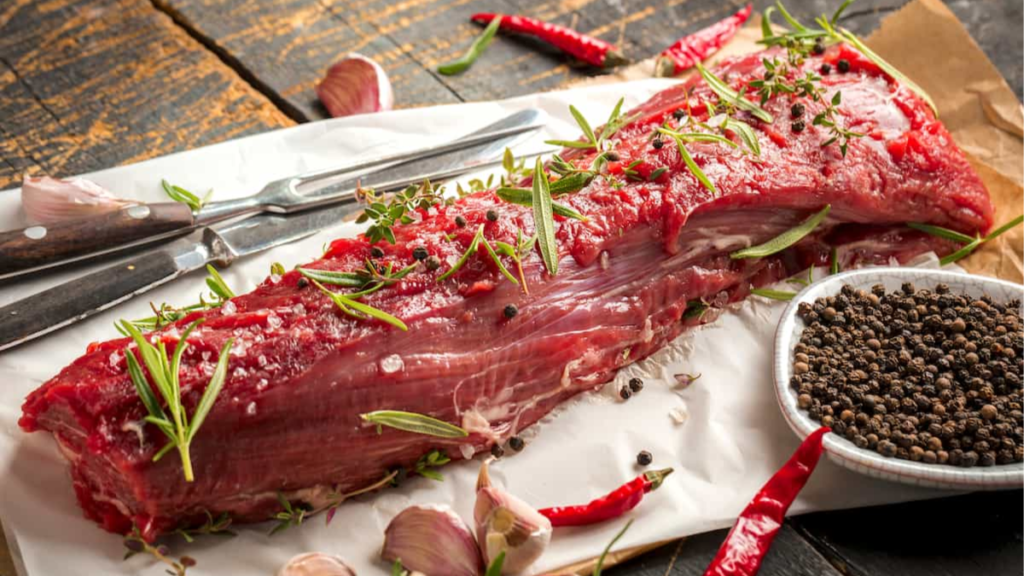Bison are part of the Bovidae family, including cattle, which includes over 100 species of hoofed mammals. While they are frequently confused with buffalo, their anatomical features differ slightly. Bison has traditionally been the second most popular red meat, with beef topping the list. Because of increased marketing efforts, widespread availability, and a favourable nutritional profile, bison meat is now in high demand. Bison is an excellent option for those looking for a leaner alternative to beef but still want the flavour of red meat. Bison has a similar texture, flavour, and appearance to beef, but it’s leaner and higher in nutrients (depending on the cut). Try bison steaks, roasts, or ground meat in your favourite recipes.
Bison has fewer calories, fat, and saturated fat than beef. Protein, omega-3 fatty acids, iron, selenium, and specific B vitamins are higher. This less-common meat may be a healthier alternative to America’s preferred red meat.
Bison Meat Nutrition Facts
What is Bison Meat?
Buffalo meat is also known as bison meat. While bison is the correct name, the two terms are often used interchangeably to refer to a large, four-legged, horned animal that looks like an ox or a cow. These animals have shaggy hair on their necks and shoulders that form a mane and a hump. They eat grass, leaves, and shrubs in the same way cows do. Then they regurgitate what they’ve swallowed, known as cud, and chew it, indicating that they’re ruminants. Buffalo meat is extremely lean and has become popular in supermarkets. It is much lower in calories and cholesterol than beef or chicken.
What are the Health Benefits of Bison Meat?
Like other meats, bison’s complete protein and essential mineral content help support an active lifestyle.
Promotes Muscle Recovery
Protein is critical for recovery following a strenuous workout. Bison is an excellent source of high-quality protein, which your body can use to build muscle. Getting your protein from natural food sources like bison gives you more vitamins and minerals to help you build strength.
Improves Wound Healing
A 4-ounce bison patty contains just over 3 milligrams of zinc, a crucial mineral for wound healing. Because meat-based zinc is more bioavailable than vegetarian zinc, bison provides a form of zinc easy for your body to absorb. 7 Zinc intake should be between 8 and 11 milligrams per day. Bison can assist you in achieving this goal.
Supports Bone Strength
Strong bones allow seniors to remain active and independent. Protein is essential for maintaining muscle mass as well as bone strength. A study of 70-year-old men’s self-reported intakes discovered a link between protein consumption and bone strength. Including enough protein in your diet, such as bison, can help your bones stay strong as you get older.
Helps Prevent Anemia
Anemia can come in various forms, and two of the most common are caused by a deficiency in iron or B12.
Iron deficiency anemia is caused by blood loss or a lack of dietary iron, and symptoms include fatigue, weakness, dizziness, memory and thinking problems, headaches or dizziness, dry, brittle hair, skin, and nails, and pica (strange cravings for metal, dirt, paper, or starchy food).
Vitamin B12 deficiency or poor absorption are linked to pernicious anemia. Fatigue, dizziness, paleness, and a rapid heart rate are symptoms of this type of anemia. Consuming bison, high in iron and vitamin B12, can help you avoid becoming anemic. If you have anemia symptoms, make an appointment with your doctor for a diagnosis and treatment.
Reduces Cancer Risk (vs. Processed Meats)
Processed meat consumption has been linked to many health issues, including an increased risk of colon cancer. By substituting whole, unprocessed bison products for processed meats (such as hot dogs or deli meat), you can enjoy red meat while avoiding some of the cancer risks associated with processed meats.
Downsides to Consider
While eating bison regularly may come with several potential benefits, it has a couple of drawbacks to consider
Price
One of the significant disadvantages of regularly eating bison is its high cost in most areas. This is because market prices are determined by supply and demand. Furthermore, grass-fed bison is generally more expensive than grass-fed beef, though this varies by demographic area.
Due to large-scale farming, traditionally farmed beef has been the least expensive, though the nutritional profile of this meat is likely to be different. Purchasing bison in bulk or on sale are two simple ways to enjoy it despite its higher price.
Easy to Overcook
Because bison is leaner than other red meats, such as beef, it’s easier to overcook, resulting in a dry, challenging, and difficult-to-chew meal. Ground bison may require slightly less cooking than other types of red meat, though this only applies to steaks and whole-muscle cuts. A food thermometer is one way to control cooking time. Ground bison should be cooked to an internal temperature of 160 degrees Fahrenheit (71 degrees Celsius), while steaks and roasts should be cooked to 145 degrees Fahrenheit (63 degrees Celsius). Overcooking can also be avoided by lowering the flame or cooking temperature slightly. Cooking bison to your preferred doneness may take some practice, as it does with any new food.
Is Bison Better for you than Beef?
While bison and beef have many similarities, they also have subtle differences. Because bison is leaner than beef, it has fewer calories and is easier to overcook. Bison and beef have similar flavours and textures, though different cuts of meat may have slight differences in flavour and texture. Another area where the two types may differ is in farming methods. Most beef is raised on factory farms using grain as a feed, promoting rapid weight gain and growth. Meanwhile, bison is typically grass-fed and pasture-raised, though some farmers supplement grain feed as demand grows, whether grass-fed or grain-fed. Bison and beef can both be nutritious components of a balanced diet.
What is Storage and Food Safety?
Bison follows the same food safety regulations as other meats. Before cooking, raw bison should be kept cold (40 degrees Fahrenheit or less). 14 To maintain optimum quality, refrigerate bison for 3–5 days or freeze it for up to 4 months at 0 degrees Fahrenheit. Bison can be frozen in its original packaging, but if freezing for more than two months, it should be wrapped in airtight, heavy-duty foil or plastic wrap. Refrigerate, or thaw frozen bison under cold running water or in the microwave. After thawing, cook ground bison to an internal temperature of 160 degrees Fahrenheit. The internal temperature of bison steaks and roasts should be 145 degrees Fahrenheit. Eat or freeze bison within 3–4 days of cooking.
Varieties
Bison was traditionally more likely to be grass-fed than conventional beef. Bison have also been praised for their health and environmental benefits, owing to their natural grazing patterns on open pastures. More and more bison have been grain-finished to produce a fattier flavour and a more consistent product.
Bison meat labelled “100% grass-fed” must come from animals that have only eaten grass. If grains were a part of their diet, the label must state so (for example, “85 percent grass and 15 percent corn”). 13 If you prefer grass-fed meat, read the labels carefully (which may be leaner than grain-fed meat).
As people become more aware of the benefits of bison, more bison products are becoming available. Frozen bison patties or bison jerky may be available at your local grocery store. While these products make eating bison more convenient, they may contain additives that should be consumed in moderation. Check the ingredients on food labels to see what’s in your buying products.
Conclusion
Bison, like cattle, belong to the Bovidae family of hoofed mammals. Bison meat is similar to beef but differs slightly in that it is leaner and typically grass-fed. Its nutritional profile may help to improve overall health, and its versatility makes it a viable red meat alternative. Bison can be a nutritious addition to a well-balanced, whole-foods diet. Most people prefer bison to beef because of the hay and grass diet that free-range animals consume. Because it’s denser and lower in fat, it doesn’t have the same juiciness as a hamburger or ribeye.
That isn’t to say it isn’t tasty. The rich, dark red meat has flavours most similar to beef, though it can be a little stronger in some cases. Bison is available in grocery stores and butcher shops for those interested in lean meats, but it is not as popular or widely available as cow’s meat. Despite being farmed, most bison roam free, eating natural grasses and hay, enhancing the meat’s flavour, texture, and fat content.



